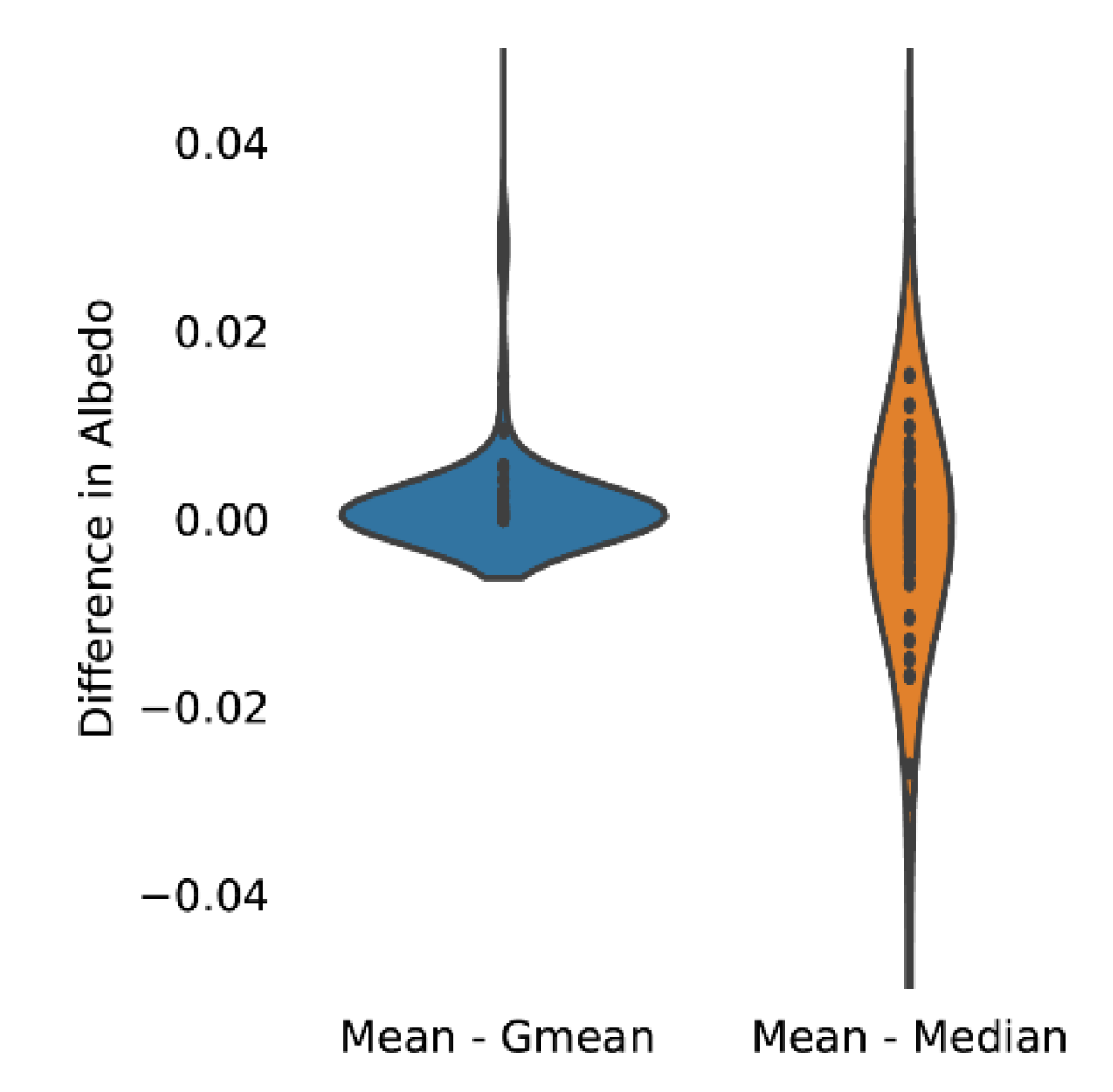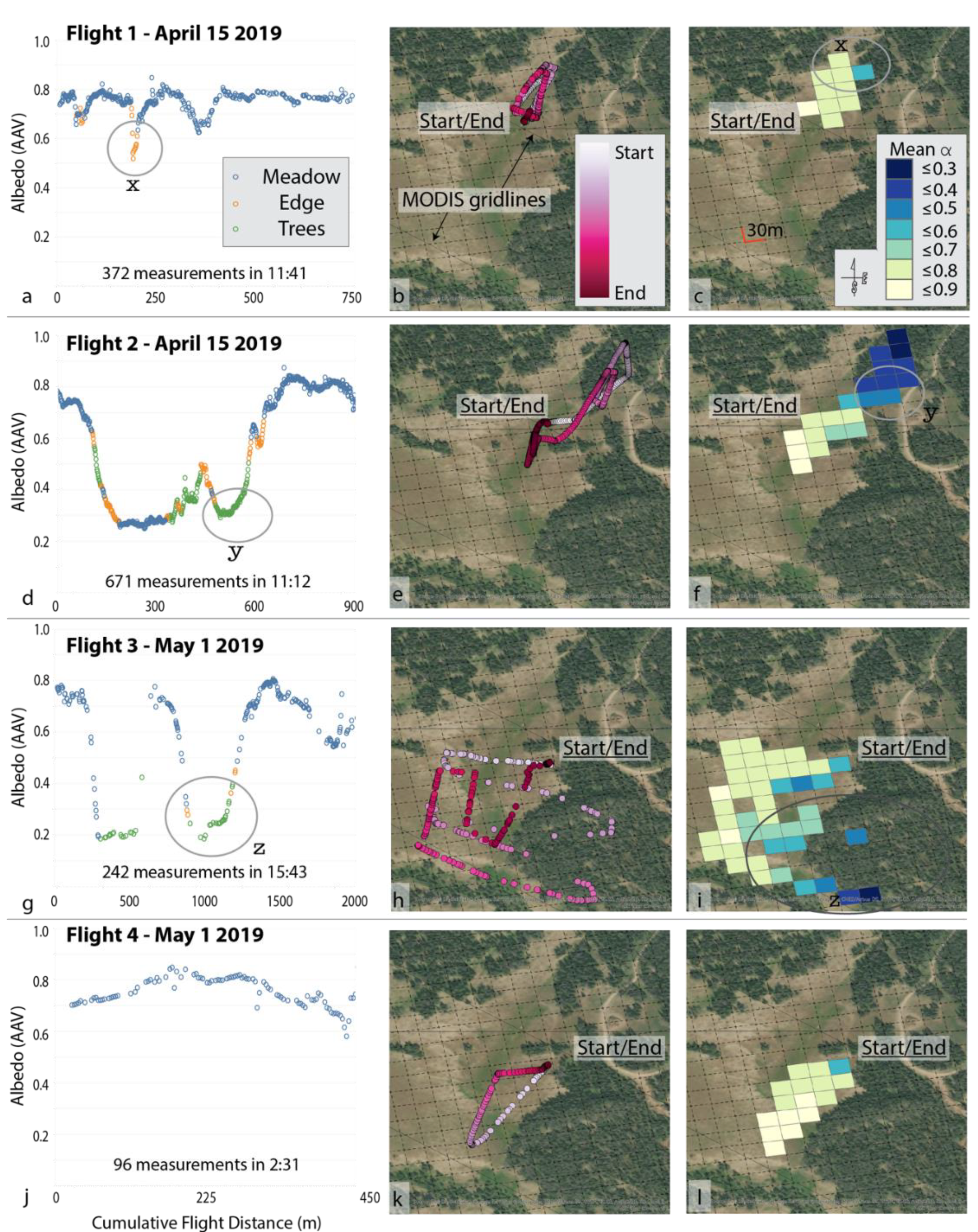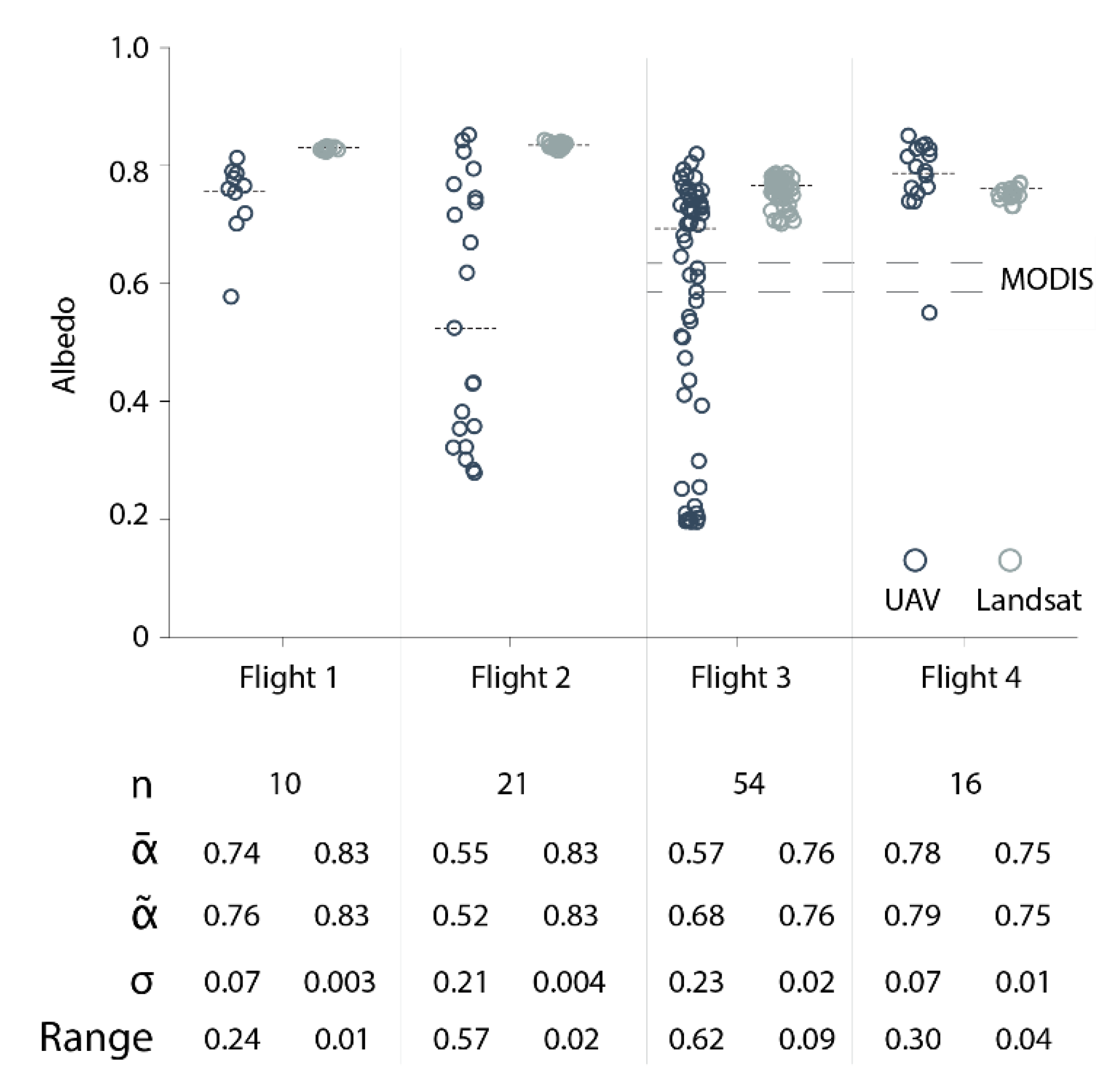Autonomous Aerial Vehicles (AAVs) as a Tool for Improving the Spatial Resolution of Snow Albedo Measurements in Mountainous Regions
Abstract
:1. Introduction
1.1. Current Methods of Measuring Albedo
1.2. Opportunities to Improve Measurements of Albedo
2. Materials and Methods
2.1. Pyranometers and AAV
2.2. Flight Planning
2.3. Study Area and Flight Descriptions
2.4. Post-Processing of Data
2.5. Reducing Oversampling of AAV Measurements for Comparison to Space-Borne Data
2.6. Space-Borne-Data
3. Results
3.1. Testing of AAV and Calibration of Sensors
3.2. Metrics From Flight Data
3.3. Albedo Measurements Across a Snowy Landscape
3.4. AAV-Based Albedo Measurements Compared to Landsat and MODIS Data
4. Discussion
Identifying a Path Forward for AAV-Based Measurements of Albedo
5. Conclusions
Author Contributions
Funding
Acknowledgments
Conflicts of Interest
Appendix A
| Dimensions | Unfolded, propellers and landing gears included, 883 × 886 × 398 mm |
| Folded, propellers and landing gears excluded, 722 × 282 × 242 mm | |
| Weight | Approx. 4.8 kg (with two TB55 batteries); |
| Max Takeoff Weight | 6.14 kg |
| Max Payload | 1.34 kg |
| Operating Frequency | 2.4000–2.4835 GHz; 5.725–5.850 GHz |
| Hovering Accuracy (P-mode with GPS) | Vertical: ± 1.64 feet (±0.5 m) or ± 0.33 feet (±0.1 m, Downward Vision System enabled) |
| Horizontal: ± 4.92 feet (±1.5 m) or ± 0.98 feet (±0.3 m, Downward Vision System enabled) | |
| Max Angular Velocity | Pitch: 300°/s, Yaw: 120°/s |
| Max Pitch Angle (Dual Downward Gimbal/Single Upward Gimbal) | S-mode: 30°; P-mode: 30° (Forward Vision System enabled: 25°); A-mode: 30° |
| Max Pitch Angle (Single Downward Gimbal (Gimbal Connector I)) | S-mode: 35°; P-mode: 30° (Forward Vision System enabled: 25°); A-mode: 30° |
| Max Ascent Speed | 16.4 ft/s (5 m/s) |
| Max Descent Speed (vertical) | 9.8 ft/s (3 m/s) |
| Max Speed (Dual Downward Gimbal/Single Upward Gimbal) | S-mode/A-mode: 73.8 kph (45.9 mph); P-mode: 61.2 kph (38 mph) |
| Max Speed (Single Downward Gimbal (Gimbal ConnectorI)) | S-mode/A-mode: 81 kph (50.3 mph); P-mode: 61.2 kph (38 mph) |
| Max Service Ceiling Above Sea Level | 3000 m, with 1760S propellers |
| Max Wind Resistance | 39.4 ft/s (12 m/s) |
| Max Flight Time (with two TB55 batteries) | M210 V2: 34 min (no payload), 24 min (takeoff weight: 6.14 kg) |
| Supported DJI Gimbals | Zenmuse X4S/X5S/X7/XT/XT2/Z30 |
| Supported Gimbal Configurations | Single Downward Gimbal, Dual Downward Gimbals, Single Upward Gimbal |
| GNSS | M210 V2: GPS+GLONASS; |
| Operating Temperature | −20° to +50 °C |
Appendix B
| Spectral range (50% points) | 310–2700 nm |
| Response time (63%) | <0.1 s |
| Response time (95%) | <0.2 s |
| Zero offset A | <15 W/m² |
| Zero offset B | <5 W/m² |
| Directional response (up to 80° with 1000 W/m² beam) | 20 W/m² |
| Temperature dependence of sensitivity (−20 °C to +50 °C) | <3% |
| Analogue output (-V version) | 0–1 V |
| Analogue output (-A version) | 4–20 mA |
| Digital output | 2-wire RS-485 |
References
- Dickinson, R.E. Land surface processes and climate—Surface albedos and energy balance. In Advances in Geophysics; Elsevier: London, UK, 1983; Volume 25, pp. 305–353. [Google Scholar]
- Franch, B.; Vermote, E.F.; Claverie, M. Intercomparison of Landsat albedo retrieval techniques and evaluation against in situ measurements across the US SURFRAD network. Remote Sens. Environ. 2014, 152, 627–637. [Google Scholar] [CrossRef]
- Sun, Q.; Wang, Z.; Li, Z.; Erb, A.; Schaaf, C.B. Evaluation of the global MODIS 30 arc-second spatially and temporally complete snow-free land surface albedo and reflectance anisotropy dataset. Int. J. Appl. Earth Obs. Geoinf. 2017, 58, 36–49. [Google Scholar] [CrossRef]
- Lucht, W.; Schaaf, C.; Strahler, A.H.; d’Entremont, R. Remote Sensing of Albedo Using the BRDF in Relation to Land Surface Properties. In Observing Land from Space: Science, Customers and Technology; Verstraete, M.M., Menenti, M., Peltoniemi, J., Eds.; Springer Netherlands: Dordrecht, The Netherlands, 2000; ISBN 978-0-306-48124-6. [Google Scholar]
- He, T.; Liang, S.; Song, D.-X. Analysis of global land surface albedo climatology and spatial-temporal variation during 1981–2010 from multiple satellite products. J. Geophys. Res. Atmos. 2014, 119, 10,210–281,298. [Google Scholar] [CrossRef]
- Dozier, J. Mountain hydrology, snow color, and the fourth paradigm. Eos, Trans. Am. Geophys. Union 2011, 92, 373. [Google Scholar] [CrossRef]
- Sproles, E.A.; Crumley, R.L.; Nolin, A.W.; Mar, E.; Moreno, J.I.L. SnowCloudHydro—A New Framework for Forecasting Streamflow in Snowy, Data-Scarce Regions. Remote Sens. 2018, 10, 1276. [Google Scholar] [CrossRef] [Green Version]
- Coakley, J.A. Reflectance and Albedo, Surface. Encycl. Atmos. Sci. 2003, 1914–1923. [Google Scholar] [CrossRef]
- DeWalle, D.R.; Rango, A. Principles of Snow Hydrology; Cambridge University Press: Cambridge, UK, 2008; ISBN 0521823625. [Google Scholar]
- Wiscombe, W.J.; Warren, S.G. A Model for the Spectral Albedo of Snow. I: Pure Snow. J. Atmos. Sci. 1980, 37, 2712–2733. [Google Scholar] [CrossRef] [Green Version]
- Winter, K.J.-P.M.; Kotlarski, S.; Scherrer, S.C.; Schär, C. The Alpine snow-albedo feedback in regional climate models. Clim. Dyn. 2017, 48, 1109–1124. [Google Scholar] [CrossRef]
- Webster, C.; Jonas, T. Influence of canopy shading and snow coverage on effective albedo in a snow-dominated evergreen needleleaf forest. Remote Sens. Environ. 2018, 214, 48–58. [Google Scholar] [CrossRef]
- National Academies of Sciences Engineering and Medicine. Thriving on Our Changing Planet: A Decadal Strategy for Earth Observation from Space; National Academies Press: Washington, DC, USA, 2018. [Google Scholar]
- Bair, E.H.; Rittger, K.; Skiles, S.M.; Dozier, J. An examination of snow albedo estimates from MODIS and their impact on snow water equivalent reconstruction. Water Resour. Res. 2019. [Google Scholar] [CrossRef]
- NASA—Applied Sciences Program Water Resources Program | Applied Sciences Website. Available online: https://appliedsciences.nasa.gov/programs/water-resources-program (accessed on 22 May 2018).
- Hall, D.K.; Riggs, G.A. MODIS/Terra Snow Cover Daily L3 Global 500m Grid, Version 6; NASA National Snow and Ice Data Center Distributed Active Archive Center: Boulder, CO, USA, 2016. [Google Scholar] [CrossRef]
- He, T.; Liang, S.; Wang, D.; Cao, Y.; Gao, F.; Yu, Y.; Feng, M. Evaluating land surface albedo estimation from Landsat MSS, TM, ETM +, and OLI data based on the unified direct estimation approach. Remote Sens. Environ. 2018, 204, 181–196. [Google Scholar] [CrossRef]
- Román, M.O.; Gatebe, C.K.; Shuai, Y.; Wang, Z.; Gao, F.; Masek, J.G.; He, T.; Liang, S.; Schaaf, C.B. Use of in situ and airborne multiangle data to assess MODIS-and Landsat-based estimates of directional reflectance and albedo. IEEE Trans. Geosci. Remote Sens. 2013, 51, 1393–1404. [Google Scholar] [CrossRef]
- Wang, Z.; Schaaf, C.B.; Strahler, A.H.; Chopping, M.J.; Román, M.O.; Shuai, Y.; Woodcock, C.E.; Hollinger, D.Y.; Fitzjarrald, D.R. Evaluation of MODIS albedo product (MCD43A) over grassland, agriculture and forest surface types during dormant and snow-covered periods. Remote Sens. Environ. 2014, 140, 60–77. [Google Scholar] [CrossRef] [Green Version]
- Kharbouche, S.; Muller, J.-P.; Gatebe, C.K.; Scanlon, T.; Banks, A.C. Assessment of Satellite-Derived Surface Reflectances by NASA’s CAR Airborne Radiometer over Railroad Valley Playa. Remote Sens. 2017, 9, 562. [Google Scholar] [CrossRef] [Green Version]
- Levy, C.; Burakowski, E.; Richardson, A. Novel Measurements of Fine-Scale Albedo: Using a Commercial Quadcopter to Measure Radiation Fluxes. Remote Sens. 2018, 10, 1303. [Google Scholar] [CrossRef] [Green Version]
- Román, M.O.; Schaaf, C.B.; Woodcock, C.E.; Strahler, A.H.; Yang, X.; Braswell, R.H.; Curtis, P.S.; Davis, K.J.; Dragoni, D.; Goulden, M.L.; et al. The MODIS (Collection V005) BRDF/albedo product: Assessment of spatial representativeness over forested landscapes. Remote Sens. Environ. 2009, 113, 2476–2498. [Google Scholar] [CrossRef] [Green Version]
- Rennie, J.J.; Lawrimore, J.H.; Gleason, B.E.; Thorne, P.W.; Morice, C.P.; Menne, M.J.; Williams, C.N.; de Almeida, W.G.; Christy, J.R.; Flannery, M.; et al. The international surface temperature initiative global land surface databank: Monthly temperature data release description and methods. Geosci. Data J. 2014, 1, 75–102. [Google Scholar] [CrossRef]
- Arnold, N.S.; Rees, W.G.; Hodson, A.J.; Kohler, J. Topographic controls on the surface energy balance of a high Arctic valley glacier. J. Geophys. Res. Earth Surf. 2006, 111. [Google Scholar] [CrossRef]
- Fonstad, M.A.; Dietrich, J.T.; Courville, B.C.; Jensen, J.L.; Carbonneau, P.E. Topographic structure from motion: A new development in photogrammetric measurement. Earth Surf. Process. Landforms 2013, 38, 421–430. [Google Scholar] [CrossRef] [Green Version]
- Bühler, Y.; Marty, M.; Egli, L.; Veitinger, J.; Jonas, T.; Thee, P.; Ginzler, C. Snow depth mapping in high-alpine catchments using digital photogrammetry. Cryosphere 2015, 9. [Google Scholar] [CrossRef] [Green Version]
- Acumen Research and Consulting. Unmanned Aerial Vehicle (UAV) Market (By Type: Fixed Wing, Multi Rotor, Single Rotor, Hybrid; By Component: Hardware (Camera, Sensors, Others), Software; By UAV Size: Small UAV, Medium UAV, Large UAV; By Application: Military & Defense, Retail, Media & En. 2020. Available online: https://www.acumenresearchandconsulting.com/unmanned-aerial-vehicle-uav-market (accessed on 28 February 2020).
- Borovytsky, V.; Averin, D. Optical sensor for drone coordinate measurements. Opt. Photonics Adv. Dimens. Metrol. 2020, 11352, 113521J. [Google Scholar]
- Ryan, J.C.; Hubbard, A.; Box, J.E.; Brough, S.; Cameron, K.; Cook, J.M.; Cooper, M.; Doyle, S.H.; Edwards, A.; Holt, T.; et al. Derivation of High Spatial Resolution Albedo from UAV Digital Imagery: Application over the Greenland Ice Sheet. Front. Earth Sci. 2017, 5, 40. [Google Scholar] [CrossRef] [Green Version]
- Kipp & Zonen Smart Pyranometer CMP3—Kipp & Zonen. Available online: https://www.kippzonen.com/Product/201/SMP3-Pyranometer#.XTir15NKhN0 (accessed on 24 July 2019).
- Kipp & Zonen. Instruction Manual—RaZON + ALL-IN-ONE Solar Monitoring System; Kipp & Zonen: Delft, The Netherlands, 2017. [Google Scholar]
- Esri World Imagery Basemap (Scale 1m). Available online: https://services.arcgisonline.com/arcgis/rest/services/World_Imagery/MapServer/0 (accessed on 28 February 2020).
- Datfile DatCon. 2019. Available online: https://github.com/BudWalkerJava/DatCon (accessed on 28 February 2020).
- The MathWorks MATLAB and Statistics Toolbox Release. 2018. Available online: https://www.mathworks.com/help/stats/release-notes.html (accessed on 24 July 2019).
- Bogren, W.S.; Burkhart, J.; Kylling, A. Tilt error in cryospheric surface radiation measurements at high latitudes: A model study. Cryosph. 2016, 10, 613–622. [Google Scholar] [CrossRef] [Green Version]
- Dwyer, J.L.; Roy, D.P.; Sauer, B.; Jenkerson, C.B.; Zhang, H.K.; Lymburner, L.; Dwyer, J.L.; Roy, D.P.; Sauer, B.; Jenkerson, C.B.; et al. Analysis Ready Data: Enabling Analysis of the Landsat Archive. Remote Sens. 2018, 10, 1363. [Google Scholar] [CrossRef]
- NASA Specifications for MODIS Instrument. Available online: https://modis.gsfc.nasa.gov/about/specifications.php (accessed on 28 August 2019).
- Strahler, A.H.; Muller, J.; Lucht, W.; Schaaf, C.; Tsang, T.; Gao, F.; Li, X.; Lewis, P.; Barnsley, M.J. MODIS BRDF/albedo product: Algorithm theoretical basis document version 5.0. MODIS Doc. 1999, 23, 42–47. [Google Scholar]
- Liang, S. Narrowband to broadband conversions of land surface albedo I algorithms. Remote Sens. Environ. 2001. [Google Scholar] [CrossRef]
- Olmedo, G.F.; Ortega-Farías, S.; Fonseca-Luengo, D.; de la Fuente-Sáiz, D.; Fuentes Peñailillo, F.; Munafó, M.V. Albedo: Calculates Broadband Albedo from Landsat data in Midraed/Water: Actual Evapotranspiration with Energy Balance Models. 2019. Available online: https://rdrr.io/cran/water/man/albedo.html (accessed on 28 February 2020).
- Molotch, N.P.; Bales, R.C. Comparison of ground-based and airborne snow surface albedo parameterizations in an alpine watershed: Impact on snowpack mass balance. Water Resour. Res. 2006, 42. [Google Scholar] [CrossRef] [Green Version]
- AghaKouchak, A.; Farahmand, A.; Melton, F.S.; Teixeira, J.; Anderson, M.C.; Wardlow, B.D.; Hain, C.R. Remote sensing of drought: Progress, challenges and opportunities. Rev. Geophys. 2015, 53, 452–480. [Google Scholar] [CrossRef] [Green Version]
- Sproles, E.; Mullen, A.; Hendrikx, J.; Gatebe, C.; Taylor, S. Snow Albedo Measurements in Mountainous Regions Using a Dual-sensor Unmanned Aerial Vehicle (UAV) 2019. AGUFM 2019, 2019, IN14A-04. [Google Scholar]
- DJI Specifications—Matrice 200 Series V2. Available online: https://www.dji.com/matrice-200-series-v2/info (accessed on 4 September 2019).





| Time (min:sec) | Distance (m) | Velocity (ms−1) | Median Altitude (m) | |
|---|---|---|---|---|
| Flight 1 | 11:41 | 742 | 1.1 | 14 |
| Flight 2 | 11:12 | 910 | 1.3 | 39 |
| Flight 3 | 15:43 | 1940 | 2.1 | 61 |
| Flight 4 | 2:31 | 428 | 2.8 | 14 |
© 2020 by the authors. Licensee MDPI, Basel, Switzerland. This article is an open access article distributed under the terms and conditions of the Creative Commons Attribution (CC BY) license (http://creativecommons.org/licenses/by/4.0/).
Share and Cite
Sproles, E.A.; Mullen, A.; Hendrikx, J.; Gatebe, C.; Taylor, S. Autonomous Aerial Vehicles (AAVs) as a Tool for Improving the Spatial Resolution of Snow Albedo Measurements in Mountainous Regions. Hydrology 2020, 7, 41. https://doi.org/10.3390/hydrology7030041
Sproles EA, Mullen A, Hendrikx J, Gatebe C, Taylor S. Autonomous Aerial Vehicles (AAVs) as a Tool for Improving the Spatial Resolution of Snow Albedo Measurements in Mountainous Regions. Hydrology. 2020; 7(3):41. https://doi.org/10.3390/hydrology7030041
Chicago/Turabian StyleSproles, Eric A., Andrew Mullen, Jordy Hendrikx, Charles Gatebe, and Suzi Taylor. 2020. "Autonomous Aerial Vehicles (AAVs) as a Tool for Improving the Spatial Resolution of Snow Albedo Measurements in Mountainous Regions" Hydrology 7, no. 3: 41. https://doi.org/10.3390/hydrology7030041






